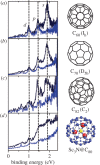Super-atom molecular orbital excited states of fullerenes
- PMID: 27501970
- PMCID: PMC4978746
- DOI: 10.1098/rsta.2015.0322
Super-atom molecular orbital excited states of fullerenes
Abstract
Super-atom molecular orbitals are orbitals that form diffuse hydrogenic excited electronic states of fullerenes with their electron density centred at the centre of the hollow carbon cage and a significant electron density inside the cage. This is a consequence of the high symmetry and hollow structure of the molecules and distinguishes them from typical low-lying molecular Rydberg states. This review summarizes the current experimental and theoretical studies related to these exotic excited electronic states with emphasis on femtosecond photoelectron spectroscopy experiments on gas-phase fullerenes.This article is part of the themed issue 'Fullerenes: past, present and future, celebrating the 30th anniversary of Buckminster Fullerene'.
Keywords: fullerene; photoelectron angular distributions; super-atom molecular orbitals.
© 2016 The Author(s).
Figures










Similar articles
-
Probing rapidly-ionizing super-atom molecular orbitals in C60: a computational and femtosecond photoelectron spectroscopy study.Chemphyschem. 2013 Oct 7;14(14):3332-40. doi: 10.1002/cphc.201300585. Epub 2013 Aug 8. Chemphyschem. 2013. PMID: 23929667
-
The influence hydrogen atom addition has on charge switching during motion of the metal atom in endohedral Ca@C60H4 isomers.Philos Trans A Math Phys Eng Sci. 2016 Sep 13;374(2076):20150319. doi: 10.1098/rsta.2015.0319. Philos Trans A Math Phys Eng Sci. 2016. PMID: 27501967 Free PMC article.
-
Hot electron production and diffuse excited states in C70, C82, and Sc3N@C80 characterized by angular-resolved photoelectron spectroscopy.J Chem Phys. 2013 Aug 28;139(8):084309. doi: 10.1063/1.4818987. J Chem Phys. 2013. PMID: 24006999
-
Pathway to the identification of C60+ in diffuse interstellar clouds.Philos Trans A Math Phys Eng Sci. 2016 Sep 13;374(2076):20150316. doi: 10.1098/rsta.2015.0316. Philos Trans A Math Phys Eng Sci. 2016. PMID: 27501976 Free PMC article. Review.
-
Fullerene ion chemistry: a journey of discovery and achievement.Philos Trans A Math Phys Eng Sci. 2016 Sep 13;374(2076):20150321. doi: 10.1098/rsta.2015.0321. Philos Trans A Math Phys Eng Sci. 2016. PMID: 27501972 Free PMC article. Review.
Cited by
-
Timing the escape of a photoexcited electron from a molecular cage.Nat Commun. 2025 May 31;16(1):5062. doi: 10.1038/s41467-025-60260-z. Nat Commun. 2025. PMID: 40450028 Free PMC article.
-
Screening in Graphene: Response to External Static Electric Field and an Image-Potential Problem.Nanomaterials (Basel). 2021 Jun 13;11(6):1561. doi: 10.3390/nano11061561. Nanomaterials (Basel). 2021. PMID: 34199308 Free PMC article.
References
-
- Kroto HW, Heath JR, O’Brien SC, Curl RF, Smalley RE. 1985. C60: Buckminsterfullerene. Nature 318, 162–163. (10.1038/318162a0) - DOI
Publication types
LinkOut - more resources
Full Text Sources
Other Literature Sources
Miscellaneous

